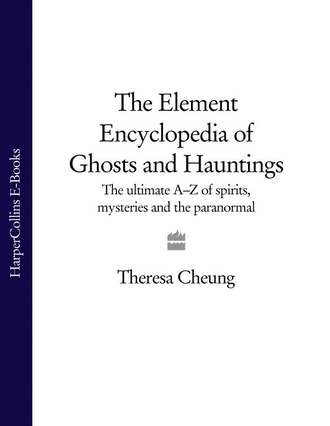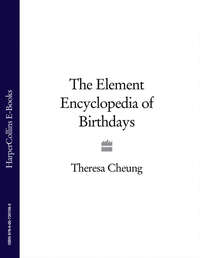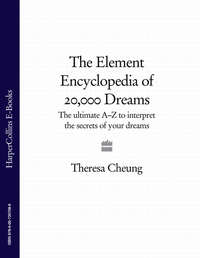
Полная версия
The Element Encyclopedia of Ghosts and Hauntings: The Complete A–Z for the Entire Magical World
Uvani permitted the ghost to possess Garrett, and the Keels said that her features looked like those of the green man. Speaking through Garrett, the ghost announced, in a medieval English accent, that he was called Charles Edward. He claimed to have been robbed of his lands by the Earl of Huntingdon and betrayed by a friend called Buckingham. He asked the witnesses to help him wreak revenge upon his enemies. Fodor informed the ghost that he was dead and begged him to give up his quest and join the spirits of his loved ones. The ghost reluctantly agreed to do so, and Garrett returned to normal consciousness.
The hauntings, however, did not stop, and Fodor conducted another session with Garrett, this time without the Keels present. The ghost once again appeared and pleaded for help in getting vengeance. Uvani announced that the Keels had used this ‘poor, unhappy creature’ in order to embarrass each other and that they did not want the ghost to leave. The control also said that if the unhappiness in the house persisted, it would become truly haunted.
Fodor at last felt that he was close to solving the case. Mrs Keel confessed to him that her husband was homosexual and that a great deal of tension existed between them. Fodor suggested that the ghost provided a distraction that prevented that tension from breaking out into the open.
When the Keels admitted they were hanging on to the ghost, the ghost departed. A scholarly investigation of the statements made by Charles Edward deemed they were not authentic, and Fodor, in analysing the case, considered the ghost to be an invention of Mr Keel’s subconscious mind, which Garrett had tapped into.
However, some of the haunting phenomena at Ash Manor could not be explained, for example, the independent sightings by servants and other witnesses. Fodor concluded that ‘it may be that those who put themselves in an unguarded psychological position, in a place filled with historical memories and traditions, do, on rare occasions, come into contact with a force or an intelligence other than their own.’
ASPORT
The opposite of apport, asport refers to psychic phenomena involving the disappearance or transportation of objects, supposedly accomplished with the help of the spirits of the dead. During the height of spiritualism in the late nineteenth and early twentieth centuries, apports produced at séances would often become asports and mysteriously vanish from one room to be found in another room. Sometimes, though, asported valuables would vanish altogether and remain forever with the spirits, causing sceptics to question the integrity of the mediums.
Although trickery is undeniable, there are also reported cases of asports that appear genuine. Sai Baba of India, famous for his apports of holy ash, food, precious jewels and other items, has also been said to dematerialize apports if the recipients do not like them and change them into something else.
ASTRAL BODY
Various esoteric traditions talk about the many bodies – the different levels of consciousness and existence – that each person has. Some people think of these different aspects as ‘subtle bodies’ or selves that exist in a parallel plane but are all part of a larger consciousness. This theory suggests that the body itself does not contain these aspects. Rather, this larger consciousness contains the body, as well as other levels of existence, and you can learn to create a closer connection to any of these aspects within yourself.
A commonly recognized ‘extra’ self is the astral body, also known as an energy body. The word ‘astral’ is derived from the Greek for ‘star’. The astral body can also be called a double or doppelgänger, because it is a duplicate of the physical body. Theosophists refer to it as the ‘etheric’ or ‘spiritual double’ containing the soul and made from the vibrations that make up the physical body.
The astral body exists on the astral plane, also known as the astral realm, astral world or astral sphere, and in metaphysical terminology the astral plane is contiguous in space, if not in time, with the material world. The astral realm is the one that the spiritual part or astral body enters during periods of sleep, under the action of anaesthetics or drugs, by accident when a person is unconscious, or immediately after death. The astral realm is not normally visible to ordinary sight, yet it is regarded as the proper dwelling of people’s higher spiritual bodies.
According to shamans and Theosophists the astral body or second self resembles the physical body but is made up of a subtle field of shining and flexible light that encases the body, visible only by a psychically sensitive person. It is thought that when you are sleeping the astral body can separate from the physical body, which results in flying dreams and the experience of disorientation experienced if you wake suddenly and the astral body hasn’t had time to line up with the physical one. Driven by emotions, passions and desires, the astral body is believed to be a bridge between the physical brain and a higher level of mind.
ASTRAL DOORWAYS
Symbols and pictures that are used to help individuals in astral projection reach the astral plane. Tarot cards can be used as astral doorways but the definitive doorways, used by psychics and magicians for hundreds of years, are the Tattwas of the Eastern esoteric tradition. The five primary tattwa symbols are simple coloured shapes – a yellow square (earth), blue circle (air), red triangle (fire), silver crescent (moon) and black oblong (ether) – and each one can be used as a focal point to trigger astral projection and give access to a specific part of the astral plane.
ASTRAL PLANE
According to occultists the astral plane is an alternate and non-physical dimension of reality that can be visited during astral projection or out-of-body experiences. The word ‘astral’, from the Greek word meaning ‘star’, originally described the heavens of the Greek gods, but as time passed the concept expanded to refer to a spirit world inhabited by etheric entities, disembodied spirits and higher beings.
The astral world is believed to be invisible to the ordinary eye because it vibrates at a higher rate than the energy that comprises the material world. However, occultists believe that it can be perceived through astral projection and clairvoyance and it is a world just as real as ours. It has scenery, inhabitants, countries and seas and is subject to the laws of nature and constant change just as the physical world is.
Modern psychologists argue that accounts of trips to a strange and alien dimension spring from the imagination, but according to occult theory the astral plane is undeniably real. It is an intermediate and invisible level of reality between the physical plane and the divine realms where communication with higher beings can be established and where the individuals thought forms take on a reality.
ASTRAL PROJECTION/ASTRAL TRAVEL
The astral body is believed to be capable of a very special type of travel. While leaving the physical body at rest, it can get up, walk around and look at its physical body, explore its surroundings and journey to new places. What makes this experience unique is that you are fully conscious and in control throughout the experience.
This process of consciously leaving the body and travelling free of physical constraints is often referred to as astral projection or astral travel. Although the terms are often used interchangeably, experts define astral projection as becoming aware that your consciousness is separate from your physical body. For instance, people describe floating above themselves and viewing their bodies during astral projection. With astral travel an individual uses this conscious awareness to experience a sense of flying to new, non-physical or physical realms.
How the mind disconnects from its everyday type of consciousness and separates from the body remains a mystery. Experts agree that having a relaxed focus, such as in meditation or when you are just about to fall asleep, helps you to reach that state, as concentrating too hard on achieving the experience may interfere with the process.
See also aura, bilocation, out-of-body experiences, lucid dreaming and near-death experiences.
ATHENODORUS, THE HAUNTING OF
The story of Athenodorus may be the first written record of a haunting, and it dates back at least 2,000 years. The story was related by several ancient authors, the historian Tacitus among them, but the version opposite is by the
Getting Started on the Astral Traveller’s path
Like any skill, astral travel takes time and practise, and it is difficult to prove what actually happens, but those experienced in astral travel tell fascinating stories of their experiences. Some travel to secret realms where they meet spirit guides and spend hours researching ancient texts. When they wake up, their clocks show that only a few minutes have passed. In all likelihood most of us won’t be able to accomplish these feats. But here is an exercise that can help you get started on the astral traveller’s path:
While relaxing, imagine your astral body positioned just in front or above you in the exact position of your physical body.
Take note of how your astral body looks. Check out the back of your head and body and parts of your body you can’t normally see.
Allow your consciousness to move into your astral body and look at your surroundings from this new perspective.
Ponder what you would like to do next and where you would like to go. You may want to visit a place or person who is normally far away, through a process called targeting. This can be done by focusing on the image of the location or the person’s face, then seeing it at the end of a tunnel. Move forward through the tunnel until you arrive at the desired place or the intended person.
When you are ready to return, think yourself back into your physical body, and move your body until you feel comfortable back in it.
Roman letter writer Pliny the Younger (AD 61–115). In it we see the classic chain-clanking ghost, the restless corpse and even the beckoning finger. The translation is that of William Melmoth (1746), slightly revised.
There was in Athens a house, spacious and open, but with an infamous reputation, as if filled with pestilence. For in the dead of night, a noise like the clashing of iron could be heard. And if one listened carefully, it sounded like the rattling of chains. At first the noise seemed to be at a distance, but then it would approach, nearer, nearer, nearer. Suddenly a phantom would appear, an old man, pale and emaciated, with a long beard, and hair that appeared driven by the wind. The fetters on his feet and hands rattled as he moved them.
Any dwellers in the house passed sleepless nights under the most dismal terrors imaginable. The nights without rest led them to a kind of madness, and as the horrors in their minds increased, onto a path toward death. Even in the daytime – when the phantom did not appear – the memory of the nightmare was so strong that it still passed before their eyes. The terror remained when the cause of it was gone.
Damned as uninhabitable, the house was at last deserted, left to the spectral monster. But in hope that some tenant might be found who was unaware of the malevolence within it, the house was posted for rent or sale. It happened that a philosopher named Athenodorus came to Athens at that time. Reading the posted bill, he discovered the dwelling’s price. The extraordinary cheapness raised his suspicion, yet when he heard the whole story, he was not in the least put off. Indeed, he was eager to take the place. And did so immediately.
As evening drew near, Athenodorus had a couch prepared for him in the front section of the house. He asked for a light and his writing materials, then dismissed his retainers. To keep his mind from being distracted by vain terrors of imaginary noises and apparitions, he directed all his energy toward his writing.
For a time the night was silent. Then came the rattling of chains. Athenodorus neither lifted up his eyes nor laid down his pen. Instead he closed his ears by concentrating on his work. But the noise increased and advanced closer till it seemed to be at the door, and at last in the very chamber. Athenodorus looked round and saw the apparition exactly as it had been described to him. It stood before him, beckoning with one finger.
Athenodorus made a sign with his hand that the visitor should wait a little, and bent over his work. The ghost, however, shook the chains over the philosopher’s head, beckoning as before. Athenodorus now took up his lamp and followed. The ghost moved slowly, as if held back by his chains. Once it reached the courtyard, it suddenly vanished.
Athenodorus, now deserted, carefully marked the spot with a handful of grass and leaves. The next day he asked the magistrate to have the spot dug up. There they found – intertwined with chains – the bones that were all that remained of a body that had long lain in the ground. Carefully, the skeletal relics were collected and given proper burial, at public expense. The tortured ancient was at rest. And the house in Athens was haunted no more.
ATMOSPHERE
A term used by psychics to describe a feeling for the environment they are in or the people they meet. Walking into a house with an unhappy atmosphere may leave them with an unsettled feeling, whereas meeting someone who is genuinely kind and honest and friendly creates a positive feeling or atmosphere.
We all pick up information from the environment we are in and from any person we meet for the first time. On a visual level we are influenced by the way a person looks and dresses and by the colours, shapes and styles around us. Sounds and smells influence us too, even before we consciously decide if we like what we see. Operating alongside our other senses is a kinaesthetic awareness, which registers an emotional reaction to the atmosphere that exists in an environment or in a person. In some people this awareness is more developed than others, and for clairsentients, who can sense and respond to the atmospheres created by places and people, it is highly attuned, giving detailed information about the physical, emotional and energetic nature of people and places.
Few of us have not felt at some time that a place is spooky or unfriendly or that we feel irritable or afraid for no reason. When this happens we are psychically tuning in to an atmosphere, and a person who readily senses an atmosphere in a place usually has that same knack when summing up people.
Clairsentients who work with environmental energy believe that everything that happens within an environment affects the way it feels. For example, there is a discernable difference between the feeling of a room used by people who respect and love each other and the feeling of a room in which people have been in bitter competition. Practitioners of the art of feng shui know a great deal about the need to balance environmental energy, and in feng shui the placing of objects such as mirrors and ornaments can help to regulate energy that is out of balance and create a healthier, more harmonious atmosphere in which to live and work.
Some clairsentients may be able to channel a form of healing energy, which can harmonize the feeling of a room, or they may, like feng shui experts, suggest colours, shapes, objects or spiritual practices to help transform the feeling or atmosphere of an environment.
AUBREY, JOHN [1626–1697]
One of the first known collectors of ghost stories, antiquarian and biographer John Aubrey’s compilation, Miscellanies, was published in 1696 and is packed with eye-witness accounts of ghostly sightings gathered from all points of Great Britain. Aubrey’s interest in the supernatural was reinforced by his own personal experiences. In Miscellanies, Aubrey writes about strange knocking sounds on the walls of his house a few days before his father died. ‘Three or four days before my father died’, he wrote, ‘as I was in my bed about nine o’clock in the morning, perfectly awake, I did hear three distinct knocks over the bed’s head, as if it had been with a ruler or ferula.’ This mysterious incident, when combined with his interviews of others who had encountered ghosts, utterly convinced Aubrey that the spirit world existed.
AUMAKUA
A family of guardian spirits from Hawaiian mythology, the aumakua are worshipped to ensure the wellbeing of the family. The aumakua are thought to have laws that must be followed, and transgressions are sometimes punished for decades. Many believe it is of vital importance to be on good terms with your family’s aumakua, or a soul may be abandoned before it reaches the land of the dead. Such abandoned souls haunt the living and remain in limbo until another aumakua takes pity on them and leads them to their new home.
Offspring of the aumakua can be born into families, and various legends tell of people born with supernatural powers, such as the ability to transform into animals.
According to lore the aumakua escort the souls of the dead to the afterlife in a ghostly procession, and if you have not rectified your sins against the aumakua before death, you have one chance to beg for pardon when the procession reaches its first stopping place. It is believed that the aumakua take the entire body to the next world, but if for any reason the body is not taken, the family must prepare the corpse for burial and its transformation into the aumakua form, which is that of a snake or shark.
AURA
The name given to a subtle envelope of vital energy that is thought to radiate round natural objects, including human beings, animals and plants. The colours and forms of each aura are believed to be characteristic of the person, animal or thing it surrounds and to fluctuate and shift according to mood and state of health.
The aura is normally invisible, but it can be seen by clairvoyants as a halo of light and colour. Two clairvoyants viewing the same aura might see different colours or interpret it in different ways. State of health and a person’s emotions show up as differences in colours and energy patterns or breaks in an aura. Physical illness seems related to the part of the aura that is closest to the body, often called the etheric body. Some psychics see the aura as a psychic screen for the projection of information, past, present and future.
Although the body does have a magnetic field – a biofield – there is no scientific evidence that auras exist. However, the belief that the human body emits radiations of a kind that in certain circumstances becomes visible has been encountered for centuries, and was present in ancient Egypt, India, Greece and Rome. In the sixteenth century, discourses on the astral body and its ‘fiery aura’ abound, and in the eighteenth century the theory of animal magnetism was developed by Anton Mesmer, who promoted a variety of scientific experiments to try to identify the phenomenon.
Just before World War I, Dr Walter Kilner from St Thomas’s Hospital in London developed a method to view auras, which he claimed appeared as a faint haze around the body, using an apparatus that rendered ultraviolet light visible. His theory of auric diagnosis of illness linked the appearance of an aura to a patient’s health. Kilner’s work was greeted with scepticism and interrupted by the outbreak of hostilities. In 1939, Semyon Davidovich Kirlian, a Russian electrician, developed a technique that he claimed recorded auras on film, but this technique remains to be verified. See Kirlian photography.
Auras, like parking places, are easy to find when you aren’t looking for them. So if you want to see an aura, you need to feel as relaxed and calm as possible. Breathe slowly and deeply for a few minutes. Then, instead of looking directly at someone, look straight past them and casually glance in their direction, allowing your eyes to lose focus. The idea is to trick your rational brain by deliberately putting a lot of your concentration on something else, but to keep a vague focus on the person whose aura you want to read.
With practise you may see a dim haze of energy around someone. Keep breathing deeply, and the aura may brighten to a colour. Don’t expect people to light up like Christmas trees and stay that way. Visions of auras tend to be lightning quick, but the more you practise the more natural it will feel and the more likely it is for colour to become noticeable.
AUTOMATIC WRITING
The most common form of automatism, automatic writing is writing that does not come from the conscious mind and is done in an altered state of consciousness. Some attribute it to spiritual beings who are somehow able to manipulate a writing utensil in order to communicate. Psychical researchers believe automatic writing emanates from material in the person’s subconscious mind or is obtained through ESP.
Many people try automatic writing in an effort to make contact with spirits or to communicate with the dead. Typically the writer is unaware of what is being written and the writing is much faster, larger and expansive than their normal handwriting. Some people experience tingling in the arms or hands. Pens are a common tool, but slates and typewriters may also be used. Automatic writers have been known to produce mirror scripts, starting at the bottom right of the page and finishing at the top left. At the height of spiritualism, automatic writing was common in séances, and it replaced the much slower methods of spelling out messages from spirits with table rappings or pointers.
In some cases automatic writing occurs involuntarily, as in the case of Anna Windsor. In 1860 Windsor began automatic writing with her right hand, which she called Stump. Stump had a personality of its own, writing out verses and prose while the left hand did something else.
Through automatic writing, mediums have claimed to produce messages not just from deceased relatives or loved ones but from famous persons in history, such as Francis Bacon, Emanuel Swedenborg and even Jesus Christ. Frederick Myers, one of the founders of the Society for Psychical Research, found little evidence that spirits communicated through automatic writing but, curiously, after his death several mediums claimed to receive automatic writing messages from him.
While psychical researchers continue to investigate automatic writing as evidence for the existence of the spirit world, the field of psychology has adopted automatic writing. Psychologists use it as a way for the unconscious mind to express thoughts and feelings that cannot be verbalized. Automatic writing continues to be used as a therapeutic tool to this day. Some critics warn of dangers in automatic writing – they claim that the writer is vulnerable to harassment from
Exercise to practise automatic writing
Make sure you are in a calm and relaxed mood. If you feel stressed or anxious, leave it and try another day.
Find a good pen or pencil and a quiet place at a table. Sit there and let your hand move as it will. You may like to ask your hand if it has any messages for you. Hold your pen loosely in whichever hand you normally write with and let your mind roam freely. Write down whatever comes into your head for about five to ten minutes at the most.








